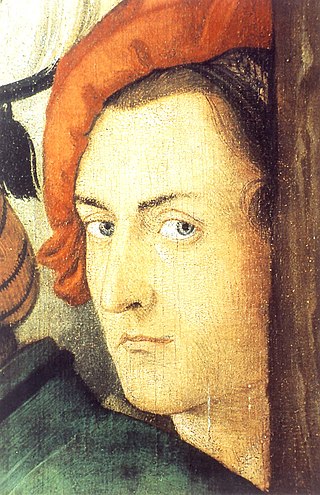
Hans Baldung, called Hans Baldung Grien,, was a painter, printer, engraver, draftsman, and stained glass artist, who was considered the most gifted student of Albrecht Dürer and whose art belongs to both German Renaissance and Mannerism.
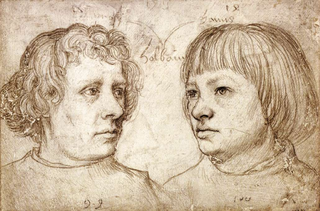
Ambrosius Holbein was a German and later a Swiss artist in painting, drawing, and printmaking. He was the elder brother, by about three years, of Hans Holbein the Younger, but he appears to have died in his mid-twenties, leaving behind only a small body of work.

Hans Holbein the Younger was a German-Swiss painter and printmaker who worked in a Northern Renaissance style, and is considered one of the greatest portraitists of the 16th century. He also produced religious art, satire, and Reformation propaganda, and he made a significant contribution to the history of book design. He is called "the Younger" to distinguish him from his father Hans Holbein the Elder, an accomplished painter of the Late Gothic school.
Death and the Maiden, a concept ultimately derived from the Medieval "Dance of Death", may refer to:
Events from the year 1517 in art.

Death and the Maiden was a common motif in Renaissance art, especially painting and prints in Germany. The usual form shows just two figures, with a young woman being seized by a personification of Death, often shown as a skeleton. Variants may include other figures. It developed from the Danse Macabre with an added erotic subtext. The German artist Hans Baldung depicted it several times.
Events from the year 1529 in art.
Events from the year 1510 in art.

The Kunstmuseum Basel houses the oldest public art collection in the world and is generally considered to be the most important museum of art in Switzerland. It is listed as a Swiss heritage site of national significance.
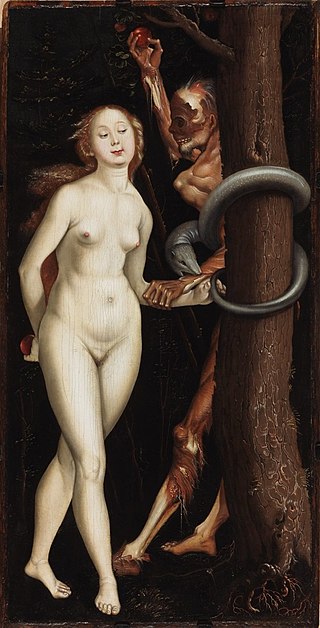
Eve, the Serpent and Death is a painting by the German Renaissance artist Hans Baldung, housed in the National Gallery of Canada, Ottawa. The date of the painting is debated, with proposals ranging from the early 1510s to between 1525 and 1530. Its four main elements are the biblical Eve, a male figure personifying Death and generally likened to Adam, a serpent, and a tree trunk.
The Three Ages of Woman and Death is an oil-on-canvas painting created between 1541 and 1544 by the German artist Hans Baldung which is in the collection of the Prado Museum, in Madrid.

The Four Witches, or The Four Naked Women, or The Four Sorceresses or Scene in a Brothel, are titles given to a 1497 engraving by the German Renaissance artist Albrecht Dürer. One of his earliest signed engravings, it shows four nude, exuberant women gathered conspiratorially in a circle in a confined interior setting, perhaps a bath house, which appears to have entrances from either side. Although clearly erotic, a small horned demon, perhaps representing temptation, is positioned in the left hand portal, peering out and holding what may be a hunting object, and is engulfed in flames.
The Amerbach Cabinet was a collection of artifacts, paintings, libraries, assembled by members of the Amerbach family, most notably by the two law professors of the University of Basel, Bonifacius Amerbach and his son Basilius Amerbach the Younger.

Hercules and Antaeus is a 1531 oil painting by German artist Hans Baldung. It was donated in 1892 by Edward Habich to the Gemäldegalerie Alte Meister (Kassel) in Germany, where it still hangs.
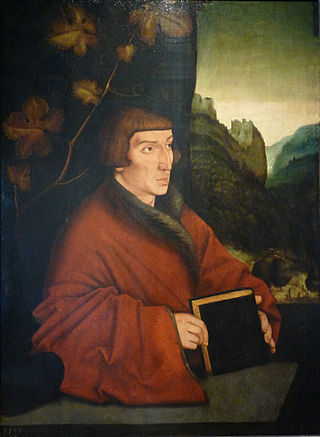
Ambrosius Volmar Keller is a 1538 portrait painting by the German Renaissance artist Hans Baldung. The painting was offered to the city of Strasbourg by German Emperor Wilhelm II, from his private collection, in 1890. It is on display in the Musée de l'Œuvre Notre-Dame. Its inventory number is MBA 191.
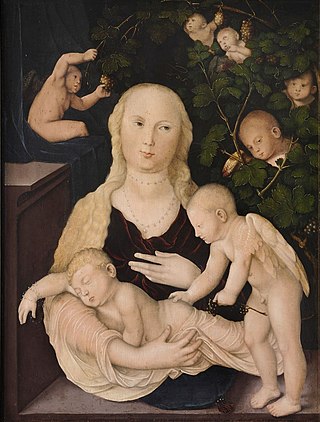
Madonna in the Vine Arbour is a circa 1541–1543 unsigned painting by the German artist Hans Baldung. It is on display in the Musée de l'Œuvre Notre-Dame. Its inventory number is MBA 536.

Bacchus is a 1638-1640 oil painting of Bacchus by Peter Paul Rubens, now in the Hermitage Museum, in Saint Petersburg, for which it was purchased in 1772. It was originally on a panel support but was transferred to canvas in 1891 by A. Sidorov. An autograph copy of the work is now in the Uffizi in Florence.

Portrait of the Artist's Family is a portrait of the family of the painter Hans Holbein the Younger by the artist himself. It depicts Holbein's wife Elsbeth Binzenstock, their son Philipp and their daughter Katharina. Holbein painted it during his stay in Basel after his return from England. It was painted, between 1528 and 1529, on paper and glued on wood.
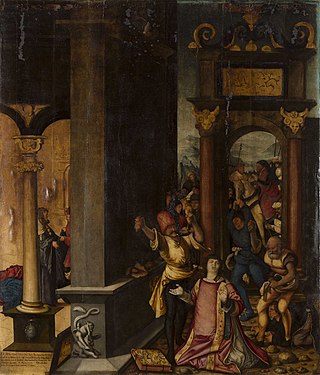
The Stoning of Saint Stephen is a 1522 painting by the German Renaissance artist Hans Baldung. It is on display in the Musée de l'Œuvre Notre-Dame. Its inventory number is MBA 315.

The Seven Ages of Woman is a painting (1544) by the German painter Hans Baldung, called Grien, executed in oil paint on linden wood. It is part of the collection of the Museum der bildenden Künste in Leipzig, Germany.














